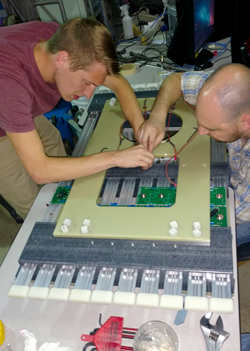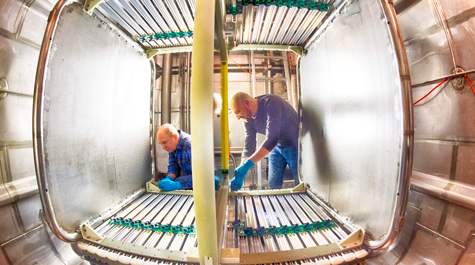Why is there anything? A big question requires a big experiment
The scope of the LBNF-DUNE project approaches the preposterous.
A thousand or so scientists, representing more than 160 institutions in 30 nations are working on an apparatus that will shoot a beam of mysterious, identity-shifting particles 800 miles through solid earth in hopes of getting a better handle on some of the most puzzling questions of science.
They’re working on designing and building what has been described in a press release from the U.S. Department of Energy’s Fermi National Accelerator Laboratory as the largest neutrino experiment ever built in the United States.
Fermilab held a July 21 groundbreaking ceremony a mile underground near Lead, South Dakota, the site of Long-Baseline Neutrino Facility (LBNF), which will house the Deep Underground Neutrino Experiment (DUNE). It was the ceremonial beginning of a project that’s been in planning for some time and is expected to go online in 2026 or so.
“The start of construction on this world-leading science experiment is cause for celebration, not just because of its positive impacts on the economy and on America’s strong relationships with our international partners, but also because of the fantastic discoveries that await us beyond the next horizon,” said U.S. Secretary of Energy Rick Perry. “I’m proud to support the efforts by Fermilab, Sanford Underground Research Facility and CERN, and we’re pleased to see it moving forward.”
 William & Mary is a member of the LBNF-DUNE collaboration, with three physics professors, a couple of post-docs, two graduate students and a number of undergraduates working on two continents.
William & Mary is a member of the LBNF-DUNE collaboration, with three physics professors, a couple of post-docs, two graduate students and a number of undergraduates working on two continents.
Jeff Nelson, professor of physics, has been working this summer at CERN, the European home of the Large Hadron Collider, along with three William & Mary undergrads, Kevin Nelson ’18, Sydney Ostrom ’20, Devin Moore ’19, plus Lauren Liegey, a graduate student in the Department of Physics.
Additional William & Mary folks working on the experiment include Michael Kordosky and Patricia Vahle, both associate professors of physics, postdocs Alex Radovic and Edgar Valencia, graduate student Luis Zazueta Reyes, recent graduate Ciaren Buteux ’16 and Will Henninger, the machine shop director in the physics department.
Kordosky explained that the primary scientific goal of LBNF-DUNE is to measure the CP phase of neutrinos. Previous experiments have narrowed down or established the mass and mixing angles of the three “flavors” of neutrinos, and he said the final step in understanding the nature of neutrinos is to get a handle on the value of the CP (charge conjugation parity) phase.
An understanding of CP phase will lead scientists to a better understanding of the puzzling imbalance of matter and antimatter in the universe, a conundrum that has implications for one of the most basic questions of all: Why is there anything?
DUNE, Kordosky explains, is designed to measure CP phase very precisely.
“The reason it’s important is that we know that we live in a universe that’s dominated by matter over antimatter,” he explained. “We don’t look out into the night sky and see regions of the universe where matter and antimatter are colliding.”
That’s not happening, yet the Standard Model, the physicists’ inventory of particles and interactions from which the universe operates, says it should be.
“In the Standard Model, matter and antimatter generally behave as mirror reflections of one another, with opposite charges,” Kordosky explained. This property is known as CP symmetry. “Given that, it is a little surprising that an excess of matter over antimatter developed in our universe.”
Collisions between matter and anti-matter particles result in grand energy-releasing events of mutual annihilation. If the quantities of matter and antimatter were equal, as predicted by CP symmetry, stuff would bang into antistuff until nothing was left.
There is some antimatter out there, produced by particle collisions and other high-energy acts of nature, but as Kordosky says, “Apparently nature has placed its thumb on the matter-antimatter scale.”
He added that the Standard Model provides for that thumb: A pair of physical constants, CP phases, could violate the matter-antimatter symmetry. The main purpose of the LBNF-DUNE experiment is a search for that symmetry-violating thumb —known as CP violation.
“In high-energy physics, we’ve been studying CP violation for quite a long time. The first place it was studied was in the quarks. The quarks have mixing angles and CP phase, just like the neutrinos do,” Kordosky explained.
Physicists found CP violation in quarks, but the effect is very small, Kordosky explained — not nearly large enough to account for matter-antimatter asymmetry.
“So what do we do? Well, the remaining place to look in the Standard Model would be in the leptons, in which the value of the CP phase not known” he said.
Leptons are a group of subatomic particles that includes neutrinos, the objects of a number of high-energy physics inquiries. Neutrinos are unbelievably numerous elementary particles, products of ongoing events that include (but are not limited to) supernovae, the fusion furnace that powers our sun and nuclear power plants.
And neutrinos are almost unbelievably hard to study. In the first place, they almost never interact with matter. Physicists say a neutrino can pass through a brick of lead a light-year thick and have only a 50 percent chance of an interaction. They come in three “flavors” — tau, muon and electron, but they “oscillate,” or change flavors midflight. Kordosky explained that a fuller understanding of the oscillation of the particles is expected to give physicists a handle on CP violation in neutrinos.
The LBNF-DUNE experiment will send a neutrino beam generated by a particle accelerator at Fermilab through two detector apparatus. There’s a near detector near the beam source and a far detector, 800 miles away in South Dakota.
“We’re in the really early stages,” Nelson said, explaining that members of the William & Mary contingent are working on design and prototypes of the detectors and other aspects of the experiment.
The group at CERN is doing R&D mainly related to the far detector, while Kordosky is the co-leader of a group designing the near detector. He said the near detector is where scientists get their first close look at the interactions of neutrinos in the beam.
“You want the near detector to perform at least as well as the far detector — better, if possible. You’re starting there; it’s your constraint. It’s the thing you use to set the null hypothesis that you test with the far detector,” he explained.
The far detector prototype is being built at CERN, and Kordosky said the near detector is just past the sketches-on-whiteboard stage.
“We’re trying now to determine what are the physics needs. If we assume a particular design for the near detector complex, what does that allow us to do?” Kordosky said. “In the design process we are also embarking on the technological research and development that is needed to construct what will be a unique, cutting edge, scientific facility, and building an international collaboration to contribute to it.”















